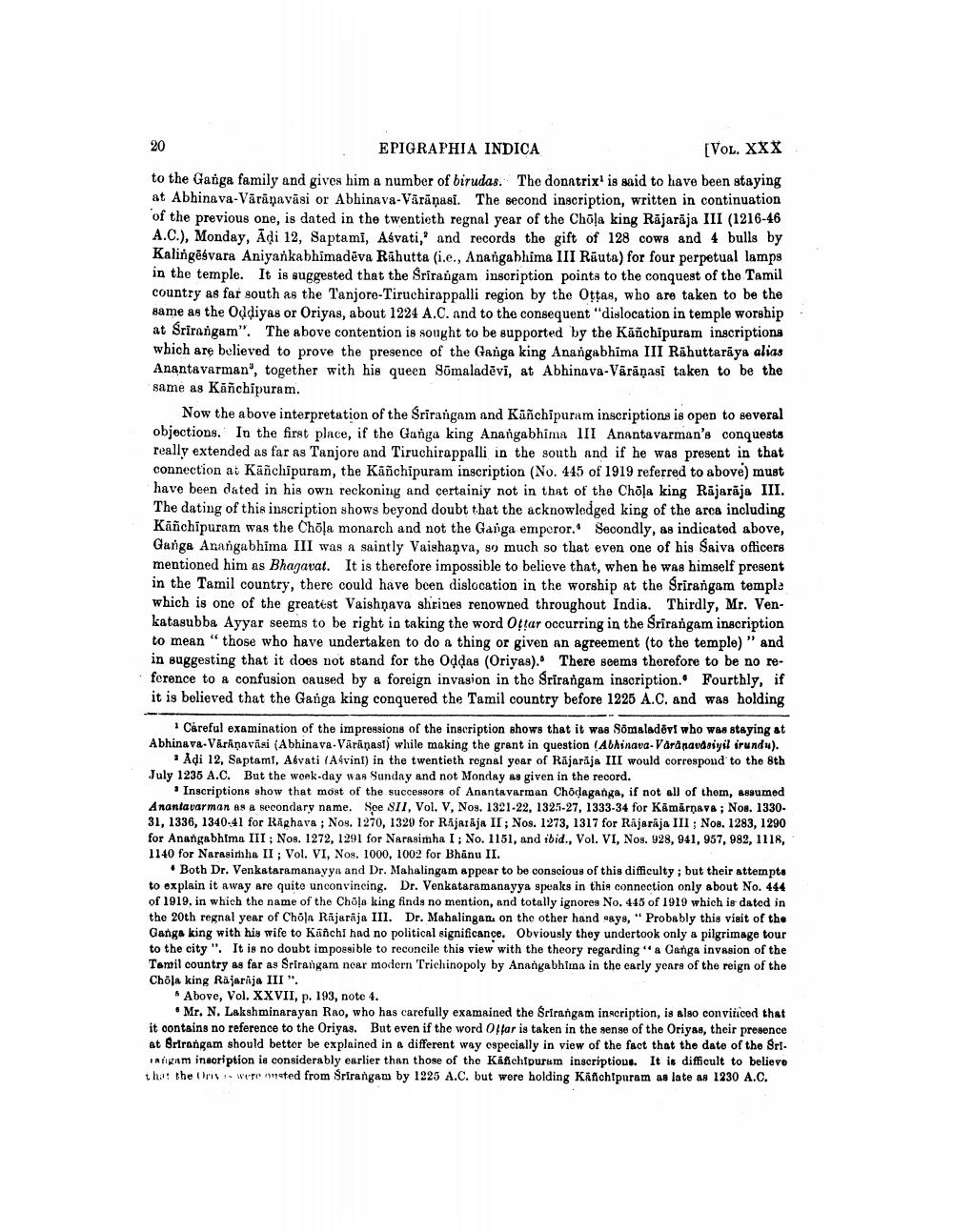________________
EPIGRAPHIA INDICA
[Vol. XXX
to the Ganga family and gives him a number of birudas. The donatrix' is said to have been staying at Abhinava-Vārāņavāsi or Abhinava-Vārāṇasī. The second inscription, written in continuation of the previous one, is dated in the twentieth regnal year of the Chola king Rājarāja III (1216-46 A.C.), Monday, Ādi 12, Saptami, Asvati,' and records the gift of 128 cows and 4 bulls by Kalingēsvara Aniyankabhimadēva Rāhutta (i.e., Anangabhima III Rauta) for four perpetual lamps in the temple. It is suggested that the Srirangam inscription points to the conquest of the Tamil country as far south as the Tanjore-Tiruchirappalli region by the Ottas, who are taken to be the same as the Oddiyas or Oriyas, about 1224 A.C. and to the consequent "dislocation in temple worship at Srirangam". The above contention is sought to be supported by the Kāñchipuram inscriptions which are believed to prove the presence of the Ganga king Anangabhima III Rāhuttarāya alias Anantavarman', together with his queen Somaladēvi, at Abhinava-Vārāṇasi taken to be the same as Káñchipuram.
Now the above interpretation of the Srirangam and Kāñchipuram inscriptions is open to several objections. In the first place, if the Ganga king Anangabhima III Anantavarman's conquests really extended as far as Tanjore and Tiruchirappalli in the south and if he was present in that connection at Kanchipuram, the Kāñchipuram inscription (No. 445 of 1919 referred to above) must have been dated in his own reckoning and certainly not in that of the Chēļa king Rājarāja III. The dating of this inscription shows beyond doubt that the acknowledged king of the area including Kanchipuram was the Chöļa monarch and not the Ganga emperor. Secondly, as indicated above, Ganga Anangabhima III was a saintly Vaishaņva, so much so that even one of his Saiva officers mentioned him as Bhagavat. It is therefore impossible to believe that, when he was himself present in the Tamil country, there could have been dislocation in the worship at the Srirangam temple which is one of the greatest Vaishnava shrines renowned throughout India. Thirdly, Mr. Venkatasubba Ayyar seems to be right in taking the word Oylar occurring in the Srirangam inscription to mean "those who have undertaken to do a thing or given an agreement (to the temple)" and in suggesting that it does not stand for the Oddas (Oriyas). There seems therefore to be no reference to a confusion caused by a foreign invasion in the Srirangam inscription. Fourthly, if it is believed that the Ganga king conquered the Tamil country before 1225 A.C. and was holding
* Careful examination of the impressions of the inscription shows that it was Somaladovi who was staying at Abhinava. Varanavisi (Abhinava. Varanasi) while making the grant in question (Abhinava-Varanaudaiyil irundu).
. Adi 12, Saptami, Afvati (Asvini) in the twentieth regnal yoar of Rājarāja III would correspond to the 8th July 1236 A.C. But the work day was Sunday and not Monday as given in the record.
Inscriptions show that most of the successors of Anantavarman Chodaganga, if not all of thom, assumed Anantavarman as a secondary name. Soe SII, Vol. V, Nos. 1321-22, 1325-27, 1333-34 for Kamarnava; Nos. 133031, 1336, 1340-41 for Rāghava ; Nos. 1270, 1329 for Rājarāja II; Nos. 1273, 1317 for Rajaraja III ; Nos. 1283, 1290 for Anangabhima III ; Nos. 1272, 1291 for Narasimha I ; No. 1151, and ibid., Vol. VI, Nos. 928, 941, 957, 982, 1118, 1140 for Narasimha II ; Vol. VI, Nos. 1000, 1002 for Bhanu II.
. Both Dr. Venkataramanayya and Dr. Mahalingam appear to be conscious of this difficulty ; but their attempts to explain it away are quite unconvincing. Dr. Venkataramanayya speaks in this connection only about No. 444 of 1919, in which the name of the Chola king finds no mention, and totally ignores No. 445 of 1919 which is dated in the 20th regnal year of Chöln Rajaraja III. Dr. Mahalingan on the other hand says, " Probably this visit of the Ganga king with his wife to Kanchi had no political significance. Obviously they undertook only a pilgrimage tour to the city". It is no doubt impossible to reconcile this view with the theory regarding "a Canga invasion of the Tamil country as far as Srirangam noar modern 'Trichinopoly by Anangabhima in the early years of the reign of the Chola king Rajarīja III".
Above, Vol. XXVII, p. 193, note 4.
Mr. N. Lakshminarayan Rao, who has carefully examined the Srirangam inscription, is also convinced that it contains no reference to the Oriyas. But even if the word ofar is taken in the sense of the Oriyas, their presence At Srirangam should better be explained in a different way especially in view of the fact that the date of the Sri. Inigam insoription is considerably earlier than those of the Kafichipuram inscriptious. It is difficult to believe that the Uns Wer t ed from Srirangam by 1225 A.C. but were holding Kanchipuram as late as 1230 A.C.




